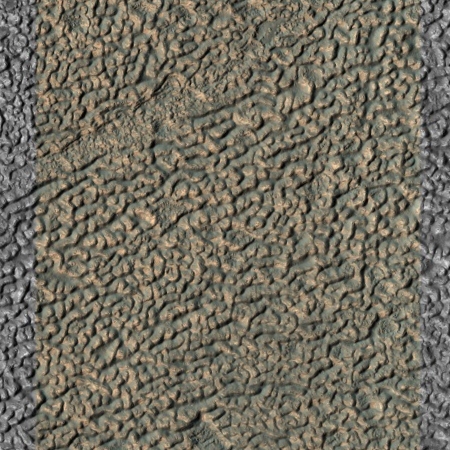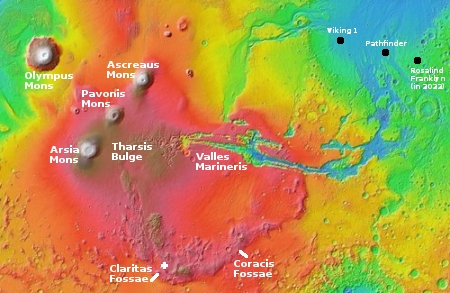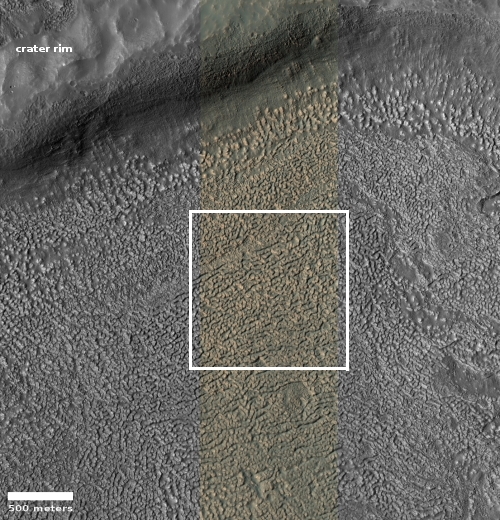Slushy floor of southern Martian crater?
The cool image to the right, rotated, cropped, and reduced to post here, shows the northwest section of the floor of a crater in the southern cratered highlands of Mars, in a mountainous region dubbed Claritus Fossae, located south of Valles Marineris. The photo was taken by the high resolution camera on Mars Reconnaissance Orbiter (MRO) on May 14, 2020.
The entire crater floor appears to be covered by these strings of closely-packed knobs, reminiscent of the brain terrain found in the mid-latitude glacial regions of Mars and thought to be the result of underground ice sublimating upward.
Below is the area in the white box, in full resolution.

To my eye this surface looks like a sheet of ice that has had hot water sprayed upon it, causing the spots where the droplets landed to melt. According to present theories, the melted spots here are instead caused when spots in the ice below the surface sublimate to a gas and pop upward, creating the depressions between the knobs. Think of the bubbles that rise in simmering tomato sauce.
Since the ice has apparently all softened, the upward popping gas does not have much problem breaking through. It is also helped by breaking through at weak points, likely the edges of multiple glacial layers (thus explaining the parallel alignments here). In a sense, we are looking a slushy ice, ready to vanish.
Why some mid-latitude glacial features look like this, while others more resemble Earth-type glaciers, remains a mystery.

The overview map to the right provides some geographic context. This crater is found at the white cross in Claritus Fossae.
Right now Mars’ rotational tilt, its obliquity, is similar to Earth’s at 25 degrees. This is also about the mid-point of the range of this obliquity, from 11 to 60 degrees. When the tilt is high, the poles are warmer than the mid-latitudes, and the water ice migrates from the former to the latter, making the glaciers active. When the tilt is low, the mid-latitude glaciers then sublimate away, their water migrating back to the poles.
It is believed that the glaciers and the poles are generally in a steady-state today, though if there is any trend it would have the mid-latitude glaciers disappearing and the poles growing. Possibly here the debris layer that usually protects Martian ice from sublimating has been blown away, allowing the ice to begin to disappear more quickly.
Or not. I am guessing. We need a closer, more detailed look to better understand Mars’ strange geology. We are only now beginning to get a real glimpse at it.
On Christmas Eve 1968 three Americans became the first humans to visit another world. What they did to celebrate was unexpected and profound, and will be remembered throughout all human history. Genesis: the Story of Apollo 8, Robert Zimmerman's classic history of humanity's first journey to another world, tells that story, and it is now available as both an ebook and an audiobook, both with a foreword by Valerie Anders and a new introduction by Robert Zimmerman.
The print edition can be purchased at Amazon or from any other book seller. If you want an autographed copy the price is $60 for the hardback and $45 for the paperback, plus $8 shipping for each. Go here for purchasing details. The ebook is available everywhere for $5.99 (before discount) at amazon, or direct from my ebook publisher, ebookit. If you buy it from ebookit you don't support the big tech companies and the author gets a bigger cut much sooner.
The audiobook is also available at all these vendors, and is also free with a 30-day trial membership to Audible.
"Not simply about one mission, [Genesis] is also the history of America's quest for the moon... Zimmerman has done a masterful job of tying disparate events together into a solid account of one of America's greatest human triumphs."--San Antonio Express-News
The cool image to the right, rotated, cropped, and reduced to post here, shows the northwest section of the floor of a crater in the southern cratered highlands of Mars, in a mountainous region dubbed Claritus Fossae, located south of Valles Marineris. The photo was taken by the high resolution camera on Mars Reconnaissance Orbiter (MRO) on May 14, 2020.
The entire crater floor appears to be covered by these strings of closely-packed knobs, reminiscent of the brain terrain found in the mid-latitude glacial regions of Mars and thought to be the result of underground ice sublimating upward.
Below is the area in the white box, in full resolution.

To my eye this surface looks like a sheet of ice that has had hot water sprayed upon it, causing the spots where the droplets landed to melt. According to present theories, the melted spots here are instead caused when spots in the ice below the surface sublimate to a gas and pop upward, creating the depressions between the knobs. Think of the bubbles that rise in simmering tomato sauce.
Since the ice has apparently all softened, the upward popping gas does not have much problem breaking through. It is also helped by breaking through at weak points, likely the edges of multiple glacial layers (thus explaining the parallel alignments here). In a sense, we are looking a slushy ice, ready to vanish.
Why some mid-latitude glacial features look like this, while others more resemble Earth-type glaciers, remains a mystery.

The overview map to the right provides some geographic context. This crater is found at the white cross in Claritus Fossae.
Right now Mars’ rotational tilt, its obliquity, is similar to Earth’s at 25 degrees. This is also about the mid-point of the range of this obliquity, from 11 to 60 degrees. When the tilt is high, the poles are warmer than the mid-latitudes, and the water ice migrates from the former to the latter, making the glaciers active. When the tilt is low, the mid-latitude glaciers then sublimate away, their water migrating back to the poles.
It is believed that the glaciers and the poles are generally in a steady-state today, though if there is any trend it would have the mid-latitude glaciers disappearing and the poles growing. Possibly here the debris layer that usually protects Martian ice from sublimating has been blown away, allowing the ice to begin to disappear more quickly.
Or not. I am guessing. We need a closer, more detailed look to better understand Mars’ strange geology. We are only now beginning to get a real glimpse at it.
On Christmas Eve 1968 three Americans became the first humans to visit another world. What they did to celebrate was unexpected and profound, and will be remembered throughout all human history. Genesis: the Story of Apollo 8, Robert Zimmerman's classic history of humanity's first journey to another world, tells that story, and it is now available as both an ebook and an audiobook, both with a foreword by Valerie Anders and a new introduction by Robert Zimmerman.
The print edition can be purchased at Amazon or from any other book seller. If you want an autographed copy the price is $60 for the hardback and $45 for the paperback, plus $8 shipping for each. Go here for purchasing details. The ebook is available everywhere for $5.99 (before discount) at amazon, or direct from my ebook publisher, ebookit. If you buy it from ebookit you don't support the big tech companies and the author gets a bigger cut much sooner.
The audiobook is also available at all these vendors, and is also free with a 30-day trial membership to Audible.
"Not simply about one mission, [Genesis] is also the history of America's quest for the moon... Zimmerman has done a masterful job of tying disparate events together into a solid account of one of America's greatest human triumphs."--San Antonio Express-News


